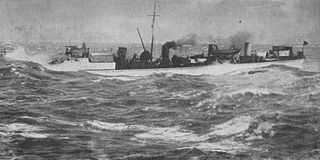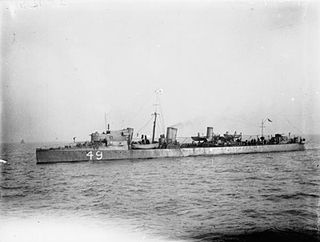Design and construction
HMS Quail was one of four 30-knot destroyers ordered from Laird's as part of the 1894–1895 Royal Navy shipbuilding programme. [5] As with other early Royal Navy destroyers, the detailed design of Quail was left to the builder, with the Admiralty laying down only broad requirements. [6] [7] In order to meet the contract speed of 30 knots (35 mph; 56 km/h)Quail was powered by two four-cylinder triple expansion steam engines, fed by four Normand boilers, rated at 6,300 ihp (4,700 kW), and was fitted with four funnels. [5] [8] She carried the specified armament for the thirty-knotters of a QF 12 pounder 12 cwt (3 in (76 mm) calibre) gun on a platform on the ship's conning tower (in practice the platform was also used as the ship's bridge), with a secondary armament of five 6-pounder guns, and two 18-inch (450 mm) torpedo tubes. [9] [10]
Quail was laid down as Yard No 606 on 28 May 1895, and was launched on 24 September 1895. [2] She reached a speed of 30.385 knots (34.966 mph; 56.273 km/h) over a measured mile and an average speed of 30.039 knots (55.632 km/h; 34.568 mph) over three hours during trials on 11 December 1896. [11] Quail commissioned in June 1897. [2] [lower-alpha 1]
Service
Newly commissioned, Quail took part in the naval review off Spithead on 26 June 1897 to celebrate the Diamond Jubilee of Queen Victoria. [4] In service, Quail proved to be a strongly-built ship, and a good seaboat, although, like other Laird-built 30-knot destroyers, manoeuvrability was poor, with a wide turning circle. [13] [8] [14]
Quail was sent to the North America and West Indies Station, based at Bermuda, being on station when the Spanish–American War broke out in 1898. [15] [16] In October 1901, Quail and the tender Columbine were ordered to Bermuda to help guard prisoners of war from the Boer War. [17] She took part in the Anglo-German naval blockade of Venezuela during the Venezuela Crisis of 1902–03. [18] Quail returned to home waters in 1903, joining the Mediterranean Fleet in October 1904, and returning to the United Kingdom in 1906. [15]
On 7 August 1907, [lower-alpha 2] Quail was involved in a collision with the scout cruiser HMS Attentive off Portland, [20] [21] during night manoeuvres, badly damaging the destroyers bow, with Quail having to be towed stern first by Adventure back to port. [22] [21] On 30 May 1910, Quail collided with the British fishing trawler Olivia off Porthallow, Cornwall, England, killing four men from the village of Flushing, Cornwall, aboard Olivia. [23] Quail was a member of the Fifth Destroyer Flotilla, based at Devonport, in 1910, and was still a member of the Fifth Flotilla in 1913. [20]
On 30 August 1912 the Admiralty directed all destroyers were to be grouped into classes designated by letters based on contract speed and appearance. As a four-funneled 30-knotter destroyer, Quail was assigned to the B Class. [24] [25]
On 19 April 1913, Quail collided with the Hull-based trawler Johannesburg on the River Humber, damaging the destroyer's bow. [26]
HMS Quail formed part of the Seventh Destroyer Flotilla based on the Humber on the outbreak of the First World War, continuing operations until the end of the war. [27] [28] [29] She was sold for breaking up on 23 July 1919. [4] [24]

HMS Sparrowhawk was a B-class torpedo boat destroyer of the Royal Navy. She was completed by Laird, Son & Company, Birkenhead, and was launched on 8 October 1895. She served on the China Station and was wrecked in the mouth of the Yangtze River in 1904. She was one of four Quail-class destroyers.
HMS Thrasher was a "thirty-knotter" torpedo boat destroyer of the British Royal Navy. She was completed by Laird, Son & Company, Birkenhead, in 1897. One of four Quail-class destroyers, she served in the First World War, sinking the German submarine UC-39 in 1917, and was sold off after hostilities ended.

HMS Virago was a B-class torpedo boat destroyer of the British Royal Navy. She was completed by Laird Brothers, Birkenhead, in 1897. One of four Quail-class destroyers she served during the Great War and was sold off after hostilities ended.

HMS Express was a B-class torpedo boat destroyer of the British Royal Navy. She was completed by Laird, Son & Company, Birkenhead, in 1896. Like many contemporary British destroyers, she was a "builder's special", designed to Admiralty specifications but built to the builder's own design.
HMS Wolf was a B-class torpedo boat destroyer of the British Royal Navy. She was completed by Laird, Son & Company, Birkenhead, in 1897.
HMS Seal was a B-class torpedo boat destroyer of the British Royal Navy. She was completed by Laird, Son & Company, Birkenhead, in 1897.
HMS Panther was a B-class torpedo boat destroyer of the British Royal Navy. She was completed by Laird, Son & Company, Birkenhead, in 1897.
HMS Locust was a B-class torpedo boat destroyer of the British Royal Navy. She was launched by Laird, Son & Company, Birkenhead, on 5 December 1896. She served in the Mediterranean between 1902 and 1906, and was used for patrol and escort duties during the First World War
HMS Griffon was a B-class torpedo boat destroyer of the British Royal Navy. She was completed by Laird, Son & Company, Birkenhead, in 1896.
HMS Earnest was an "thirty-knotter" torpedo boat destroyer of the British Royal Navy. She was built by Laird, Son & Company at their Birkenhead shipyard as one of six Earnest-class destroyers ordered as part of the Royal Navy's 1895–1896 construction programme, which were later classified as members of the B-class. Earnest was launched on 7 November 1896 and was completed in November 1897.
HMS Lively was a B-class torpedo boat destroyer of the British Royal Navy. She was built speculatively by Laird, Son & Company, Birkenhead, pre-empting further orders for vessels of this type, and was bought by the navy in 1901.
HMS Sprightly was a B-class torpedo boat destroyer of the British Royal Navy. She was built speculatively by Laird, Son & Company, Birkenhead, pre-empting further orders for vessels of this type, and was purchased by the navy in 1901.
HMS Orwell was a B-class torpedo boat destroyer of the British Royal Navy. She was built by Laird, Son & Company, and served from 1900 until 1920.
HMS Zebra was a "Twenty-seven Knotter" destroyer of the Royal Navy, later classified as part of the A Class. Zebra was built by Thames Iron Works and launched in 1895 as the fifth Royal Navy ship to be named Zebra. Entering service in 1900, Zebra was sold for scrap in 1914.

HMS Banshee was one of three Banshee-class destroyers which served with the Royal Navy.
HMS Fervent was a Fervent-class destroyer which served with the Royal Navy. Fervent was launched on 28 March 1895 at Paisley.

HMS Zephyr was one of two Fervent-class destroyers which served with the Royal Navy. She was launched on 10 May 1895 from Hanna, Donald & Wilson at Paisley, Scotland. She served in home waters, and was sold in 1920.
Four Quail-class destroyers served with the Royal Navy. These ships were all built by Laird, Son & Co. and were the first of the 'thirty knotters'.

HMS Fame was a two funnel, 30 knot destroyer of the Royal Navy, ordered under the 1894–1895 Naval Estimates. She was launched in 1896, served in Chinese waters for the whole of her life and was sold at Hong Kong in 1921.

HMS Kestrel was a Clydebank-built three funnelled 30-knot destroyer ordered by the Royal Navy under the 1895 – 1896 Naval Estimates. She was the fourth ship to carry this name since it was first used in 1846 for a brigantine.







